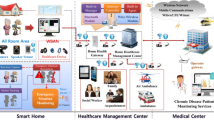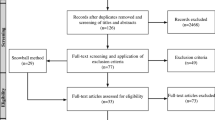Abstract
Independent living of older adults is one of the main challenges linked to the ageing population. Especially those living with diseases like COPD, MCI or frailty, need more support in everyday life and this is by itself a big societal challenge with impact in multiple sectors. In this paper we present eWALL, an innovative open-source eHealth platform that aims to address these challenges by means of an advanced cloud-based infrastructure. eWALL is designed in an innovative manner and achieved technical breakthroughs in eHealth platforms, while prioritizing user and market needs that are often abandoned and are the major reason for technically sound solutions that fail. We consider this as an opportunity and we aim to change the eHealth systems’ experience for older adults and break the barriers for the penetration of ICT solutions.














Similar content being viewed by others
Notes
References
Continua Alliance. Information available at: http://www.continuaalliance.org.
Active and Assisted Living Proogramme (AAL). Information available at: www.aal-europe.eu.
ProRec Initiative. Information available at: http://nl.prorec.be.
EuroRec Initiative. Information available at: http://www.eurorec.org.
European Patients Smart Open Services (epSOS). Information available at: http://www.epsos.eu/home.html.
Linked Data. Information available at: http://linkeddata.org/home.
Semantic Web. Information available at: http://semanticweb.org.
RolandBerger Staregy Consultants, “E-Health: Des Acteurs inattendus, quelle evolution du modele commercial?,” Paris, September 24, 2014. Available online at: http://www.rolandberger.fr/media/pdf/Roland_Berger_EHealthAndNewCommercialModel_20140924.pdf.
The PAMAP project. Information available at: http://www.pamap.org/.
DOMEO project. Information available at: http://www.aal-domeo.org/.
GiraffPlus FP7 project. Information available at: http://www.giraffplus.eu/.
The ICT4Depression FP7 project (2010–2013). Information available at: http://www.ict4depression.eu/.
The PSYCHE project (2010–2013). Information available at: http://www.psyche-project.org/.
The eHealthMonitor FP7 project (2011–2014). Information available at: http://www.ehealthmonitor.eu/.
The Mobiguide FP7 project (2011–2015). Information available at: http://www.mobiguide-project.eu/.
The DAPHNE FP7 project (2013–2016). Information available at: http://www.daphne-fp7.eu/.
The PEGASO Fit for Future FP7 project (2013–2017). Information available at: http://pegasof4f.eu/.
The PRECIOUS FP7 project (2013–2016). Information available at: http://www.thepreciousproject.eu/.
The eWALL project Deliverable D2.7: Final user and system requirements and architecture. March 2015.
TS 102 921, “Machine-to-Machine communications (M2M); mIa, dIa and mId interfaces,” ETSI, 2012.
Spring Framework. http://spring.io/.
Martin, M., Clare, L., Altgassen, A. M., Cameron, M. H., & Zehnder, F. (2011). Cognition-based interventions for healthy older people and people with mild cognitive impairment. Cochrane Database Systematic Review, 1(1), 220.
Smith, G. E., Housen, P., Yaffe, K., Ruff, R., Kennison, R. F., et al. (2009). A cognitive training program based on principles of brain plasticity: Results from the Improvement in Memory with Plasticity-based Adaptive Cognitive Training (IMPACT) study. Journal of the American Geriatrics Society, 57(4), 594–603.
Willis, S. L., Tennstedt, S. L., Marsiske, M., Ball, K., Elias, J., et al. (2006). Long-term effects of cognitive training on everyday functional outcomes in older adults. JAMA, 296(23), 2805–2814.
AngularJS framework https://angularjs.org/.
Regulation (EU) 2016/679 of the European Parliament and of the Council.
OPERANDO, EU call H2020-DS-2014-1, topic DS-01-2014—Privacy, Innovation action, EU funding of ca. 4 m euros, 2015–2018, “OPERANDO - Online Privacy Enforcement, Rights Assurance and Optimization” (653704). www.operando.eu.
Pocs, M. (2012). Will the European Commission be able to standardise legal technology design without a legal method? Computer Law & Security Review, 28, 641–650.
Liaison Agreement between eWALL Project and CEN (European Committee for Standardization), see registry of “European Partners”/”Liaison Organizations” at https://standards.cen.eu/dyn/www/f?p=CENWEB:42:::NO:::.
Agenda/meeting notes of CEN TC 251 Health Informatics, Nederlands Normalisatie-instituut (secretariat), N16-023 and N16-048, item no. 3 (eWALL project liaison contribution), Delft, The Netherlands 2016.
ETSI eHealth Workshop contribution by eWALL Project, Matthias Pocs, Standardisation project proposal “Privacy-by-Design method for the development of eHealth systems”, Sophia Antipolis, France 2014, https://docbox.etsi.org/Workshop/2014/201405_EHEALTHWORKSHOP/S06_SECURITY_PRIVACY_LEGALIMPLICATIONS/STELAR_POCS.pdf.
ANEC The European Consumer voice in standardisation, Consultation by European Commission, standardisation request on Privacy by Design for security industry, ANEC-ICT-2014-G-020 final. http://www.anec.eu/attachments/ANEC-ICT-2014-G-020final.pdf.
Davis, F. D. (1989). Perceived usefulness, perceived ease of use, and user acceptance of information technology. MIS Quarterly, 13(3), 319–339.
Laugwitz, B., Held, T., & Schrepp, M. (2008). Construction and evaluation of a user experience questionnaire. In A. Holzinger (Ed.), USAB 2008, LNCS 5298, pp. 63–76.
Lawton, M. P., & Brody, E. M. (1969). Assessment of older people: Self-maintaining and instrumental activities of daily living. Gerontologist, 9, 179–186.
Ware, J. E., & Sherbourne, C. D. (1992). The MOS 36-item Short-Form health status survey (SF-36). I. Conceptual framework and item selection. Medical Care, 30, 473.
van der Molen, T., Willemse, B. W., Schokker, S., ten Hacken, N. H., Postma, D. S., & Juniper, E. F. (2003). Development, validity and responsiveness of the Clinical COPD Questionnaire. Health and Quality of Life Outcomes, 28(1), 13.
Folstein, M. F., Folstein, S. E., & McHugh, P. R. (1975). “Mini-mental state” A practical method for grading the cognitive state of patients for the clinician. Journal of Psychiatric Research, 12(3), 189–198.
The Do CHANGE H2020 project (2015–2018). Information available at: http://www.do-change.eu/.
Acknowledgement
This paper is based on the joint research work of the eWALL project consortium (EC, FP7 Grant Agreement no 610658). The authors would like to acknowledge the research effort of all eWALL colleagues for making this paper possible, as well as the European Commission for providing the FP7 funding framework.
Author information
Authors and Affiliations
Corresponding author
Rights and permissions
About this article
Cite this article
Kyriazakos, S., Prasad, R., Mihovska, A. et al. eWALL: An Open-Source Cloud-Based eHealth Platform for Creating Home Caring Environments for Older Adults Living with Chronic Diseases or Frailty. Wireless Pers Commun 97, 1835–1875 (2017). https://doi.org/10.1007/s11277-017-4656-7
Published:
Issue Date:
DOI: https://doi.org/10.1007/s11277-017-4656-7




